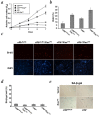Retinoblastoma loss modulates DNA damage response favoring tumor progression
- PMID: 18985151
- PMCID: PMC2573954
- DOI: 10.1371/journal.pone.0003632
Retinoblastoma loss modulates DNA damage response favoring tumor progression
Abstract
Senescence is one of the main barriers against tumor progression. Oncogenic signals in primary cells result in oncogene-induced senescence (OIS), crucial for protection against cancer development. It has been described in premalignant lesions that OIS requires DNA damage response (DDR) activation, safeguard of the integrity of the genome. Here we demonstrate how the cellular mechanisms involved in oncogenic transformation in a model of glioma uncouple OIS and DDR. We use this tumor type as a paradigm of oncogenic transformation. In human gliomas most of the genetic alterations that have been previously identified result in abnormal activation of cell growth signaling pathways and deregulation of cell cycle, features recapitulated in our model by oncogenic Ras expression and retinoblastoma (Rb) inactivation respectively. In this scenario, the absence of pRb confers a proliferative advantage and activates DDR to a greater extent in a DNA lesion-independent fashion than cells that express only HRas(V12). Moreover, Rb loss inactivates the stress kinase DDR-associated p38MAPK by specific Wip1-dependent dephosphorylation. Thus, Rb loss acts as a switch mediating the transition between premalignant lesions and cancer through DDR modulation. These findings may have important implications for the understanding the biology of gliomas and anticipate a new target, Wip1 phosphatase, for novel therapeutic strategies.
Conflict of interest statement
Figures






Similar articles
-
Oncogene-induced senescence is a DNA damage response triggered by DNA hyper-replication.Nature. 2006 Nov 30;444(7119):638-42. doi: 10.1038/nature05327. Nature. 2006. PMID: 17136094
-
Modeling the effect of the RB tumor suppressor on disease progression: dependence on oncogene network and cellular context.Oncogene. 2010 Jan 7;29(1):68-80. doi: 10.1038/onc.2009.313. Epub 2009 Oct 5. Oncogene. 2010. PMID: 19802012
-
The ability of E1A to rescue ras-induced premature senescence and confer transformation relies on inactivation of both p300/CBP and Rb family proteins.Cancer Res. 2005 Sep 15;65(18):8298-307. doi: 10.1158/0008-5472.CAN-05-0054. Cancer Res. 2005. PMID: 16166306
-
Emerging roles of RB family: new defense mechanisms against tumor progression.J Cell Physiol. 2013 Mar;228(3):525-35. doi: 10.1002/jcp.24170. J Cell Physiol. 2013. PMID: 22886479 Review.
-
The Rb family connects with the Tp53 family in skin carcinogenesis.Mol Carcinog. 2007 Aug;46(8):618-23. doi: 10.1002/mc.20338. Mol Carcinog. 2007. PMID: 17486638 Review.
Cited by
-
Protein Expression Knockdown in Cancer Cells Induced by a Gemini Cationic Lipid Nanovector with Histidine-Based Polar Heads.Pharmaceutics. 2020 Aug 21;12(9):791. doi: 10.3390/pharmaceutics12090791. Pharmaceutics. 2020. PMID: 32825658 Free PMC article.
-
Senolytic Therapy: A Potential Approach for the Elimination of Oncogene-Induced Senescent HPV-Positive Cells.Int J Mol Sci. 2022 Dec 8;23(24):15512. doi: 10.3390/ijms232415512. Int J Mol Sci. 2022. PMID: 36555154 Free PMC article. Review.
-
Wnt/β-catenin signaling induces the aging of mesenchymal stem cells through the DNA damage response and the p53/p21 pathway.PLoS One. 2011;6(6):e21397. doi: 10.1371/journal.pone.0021397. Epub 2011 Jun 21. PLoS One. 2011. PMID: 21712954 Free PMC article.
-
Gene network landscape of the ciliate Tetrahymena thermophila.PLoS One. 2011;6(5):e20124. doi: 10.1371/journal.pone.0020124. Epub 2011 May 26. PLoS One. 2011. PMID: 21637855 Free PMC article.
-
A Conversation with ChatGPT on Contentious Issues in Senescence and Cancer Research.Mol Pharmacol. 2024 Apr 17;105(5):313-327. doi: 10.1124/molpharm.124.000871. Mol Pharmacol. 2024. PMID: 38458774 Free PMC article.
References
-
- Kleihues P, Burger PC, Scheithauer BW. The new WHO classification of brain tumours. Brain Pathol. 1993;3(3):255–268. - PubMed
-
- Guha A, Feldkamp MM, Lau N, Boss G, Pawson A. Proliferation of human malignant astrocytomas is dependent on ras activation. Oncogene. 1997;15(23):2755–2765. - PubMed
-
- Feldkamp MM, Lau N, Rak J, Kerbel RS, Guha A. Normoxic and hypoxic regulation of vascular endothelial growth factor (VEGF) by astrocytoma cells is mediated by ras. Int J Cancer. 1999;81(1):118–124. - PubMed
-
- Rajasekhar VK, Viale A, Socci ND, Wiedmann M, Hu X, et al. Oncogenic ras and akt signaling contribute to glioblastoma formation by differential recruitment of existing mRNAs to polysomes. Mol Cell. 2003;12(4):889–901. - PubMed
Publication types
MeSH terms
Substances
LinkOut - more resources
Full Text Sources
Research Materials
Miscellaneous

